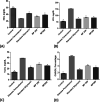UHPLC-QTOF-MS Metabolic Profiling of Marchantia polymorpha and Evaluation of Its Hepatoprotective Activity Using Paracetamol-Induced Liver Injury in Mice
- PMID: 37273612
- PMCID: PMC10233839
- DOI: 10.1021/acsomega.3c01867
UHPLC-QTOF-MS Metabolic Profiling of Marchantia polymorpha and Evaluation of Its Hepatoprotective Activity Using Paracetamol-Induced Liver Injury in Mice
Abstract
Marchantia species were traditionally used to treat liver failure. Marchantia polymorpha chloroform extract showed a marked hepatoprotective activity in a dose-dependent manner in paracetamol-induced extensive liver damage in mice. At a dose of 500 mg/kg (MP-500), it resulted in a reduction in aspartate transaminase by 49.44%, alanine transaminase by 44.11%, and alkaline phosphatase by 24.4% with significant elevation in total proteins by 58.69% with respect to the diseased group. It showed significant reductions in total bilirubin, total cholesterol, triglycerides, low density lipoprotein (LDL), very LDL, total lipids, and to high density lipoprotein ratio (CH/HDL) by 53.42, 30.14, 35.02, 45.79, 34.74, 41.45, and 49.52%, respectively, together with a 37.69% increase in HDL with respect to the diseased group. It also showed an elevation of superoxide dismutase by 28.09% and in glutathione peroxidase by 81.83% in addition to the reduction of lipid peroxidation by 17.95% as compared to the paracetamol only treated group. This was further supported by histopathological examination that showed normal liver architecture and a normal sinusoidal gap. Metabolic profiling by ultrahigh performance liquid chromatography coupled with quadrupole time-of-flight mass spectrometer (UHPLC-QTOF/MS) led to the tentative identification of 28 compounds belonging to phenols, quinolones, phenylpropanoid, acylaminosugars, terpenoids, lipids, and fatty acids to which the activity was attributed. Four compounds were detected in the negative ionization mode which are neoacrimarine J, marchantin A, chitobiose, and phellodensin F, while the rest were detected in the positive mode. Thus, it can be concluded that this plant could serve as a valuable choice for the treatment of hepatotoxicity that further consolidated its traditional use.
© 2023 The Authors. Published by American Chemical Society.
Conflict of interest statement
The authors declare no competing financial interest.
Figures





Similar articles
-
Hepatoprotective Effect of A Polyherbal Extract Containing Andrographis Paniculata, Tinospora Cordifolia and Solanum Nigrum Against Paracetamol Induced Hepatotoxicity.Pharmacogn Mag. 2015 Oct;11(Suppl 3):S375-9. doi: 10.4103/0973-1296.168945. Pharmacogn Mag. 2015. PMID: 26929570 Free PMC article.
-
Pharmacological Evaluation of Hepatoprotective Activity of AHPL/AYTAB/0613 Tablet in Carbon Tetrachloride-, Ethanol-, and Paracetamol-Induced Hepatotoxicity Models in Wistar Albino Rats.Pharmacognosy Res. 2017 Dec;9(Suppl 1):S41-S47. doi: 10.4103/pr.pr_44_17. Pharmacognosy Res. 2017. PMID: 29333041 Free PMC article.
-
Metabolomics evaluation of the effects of green tea extract on acetaminophen-induced hepatotoxicity in mice.Food Chem Toxicol. 2013 Dec;62:707-21. doi: 10.1016/j.fct.2013.09.025. Epub 2013 Sep 27. Food Chem Toxicol. 2013. PMID: 24080264
-
Protective effect of bark and empty pod extracts from Acacia auriculiformis against paracetamol intoxicated liver injury and alloxan induced type II diabetes.Food Chem Toxicol. 2013 Jun;56:162-70. doi: 10.1016/j.fct.2013.02.031. Epub 2013 Feb 26. Food Chem Toxicol. 2013. PMID: 23485614
-
Hepatoprotective activity of Mammea africana ethanol stem bark extract.Avicenna J Phytomed. 2016 Mar-Apr;6(2):248-59. Avicenna J Phytomed. 2016. PMID: 27222838 Free PMC article.
Cited by
-
Integrated transcriptome and metabolome revealed the drought responsive metabolic pathways in Oriental Lily (Lilium L.).PeerJ. 2023 Dec 18;11:e16658. doi: 10.7717/peerj.16658. eCollection 2023. PeerJ. 2023. PMID: 38130923 Free PMC article.
-
Recent Advances in the Phytochemistry of Bryophytes: Distribution, Structures and Biological Activity of Bibenzyl and Bisbibenzyl Compounds.Plants (Basel). 2023 Dec 15;12(24):4173. doi: 10.3390/plants12244173. Plants (Basel). 2023. PMID: 38140499 Free PMC article. Review.
-
Marchantia polymorpha as a Source of Biologically Active Compounds.Molecules. 2025 Jan 26;30(3):558. doi: 10.3390/molecules30030558. Molecules. 2025. PMID: 39942661 Free PMC article. Review.
-
Exploring the phytochemicals, antioxidant properties, and hepatoprotective potential of Moricandia sinaica leaves against paracetamol-induced toxicity: Biological evaluations and in Silico insights.PLoS One. 2024 Oct 9;19(10):e0307901. doi: 10.1371/journal.pone.0307901. eCollection 2024. PLoS One. 2024. PMID: 39383154 Free PMC article.
References
-
- Novianto F.; Saryanto S. Uji Klinik Fase II Ramuan Jamu Sebagai Pelindung Fungsi Hati. Ind. Bull. Health Res. 2017, 45, 125–136. 10.22435/bpk.v45i2.6359.125-136. - DOI
-
- Youssef F. S.; Ashour M. L.; El-Beshbishy H. A.; Singab A. N. B.; Wink M. Metabolic profiling of Buddleia indica leaves using LC/MS and evidence of their antioxidant and hepatoprotective activity using different in vitro and in vivo experimental models. Antioxidants 2019, 8, 412.10.3390/antiox8090412. - DOI - PMC - PubMed
-
- Brobbey A. A.; Jibira Y.; Fuseini B.; Nii-Lamptey R.; Adu J. K. Antioxidant and Hepatoprotective properties of Helianthus annuus seed extract against paracetamol-induced liver toxicity. J. Phytopharm. 2020, 9, 361–366. 10.31254/phyto.2020.9512. - DOI
LinkOut - more resources
Full Text Sources
Miscellaneous

